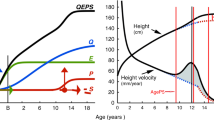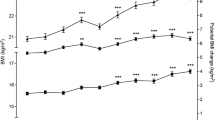Abstract
Background:
Childhood BMI may influence subsequent growth in height as well as the timing of puberty. The aim of the present study was to investigate associations between BMI in childhood and subsequent height gain/pubertal growth.
Methods:
Longitudinal growth data were used (GrowUp1990Gothenburg cohort, n = 1,901). The QEPS growth-model was used to characterize height gain in relation to the highest BMISDS value between 3.5 and 8 y of age. Children were defined as overweight/obese (OwOb) or normal weight/underweight (NwUw), using the 2012 International Obesity Task Force criteria.
Results:
A negative association between childhood BMISDS and pubertal height gain was observed. Already at birth, OwOb children were heavier than NwUw children, and had a greater height velocity during childhood. Onset of puberty was 3.5/3.0 mo earlier in OwOb girls/boys, and they had 2.3/3.1 cm less pubertal height gain from the QEPS-models specific P-function than NwUw children. Adult height was not related to childhood BMI.
Conclusion:
We found that pubertal height gain was inversely related to peak BMI in childhood. Higher childhood BMISDS was associated with more growth before onset of puberty, earlier puberty, and less pubertal height gain, resulting in similar adult heights for OwOb and NwUw children.
Similar content being viewed by others
Log in or create a free account to read this content
Gain free access to this article, as well as selected content from this journal and more on nature.com
or
References
Wikland KA, Luo ZC, Niklasson A, Karlberg J. Swedish population-based longitudinal reference values from birth to 18 years of age for height, weight and head circumference. Acta Paediatr 2002;91:739–54.
Cole TJ. Secular trends in growth. The Proceedings of the Nutrition Society 2000;59:317–24.
Schoch T, Staub K, Pfister C. Social inequality and the biological standard of living: an anthropometric analysis of Swiss conscription data, 1875-1950. Econ Hum Biol 2012;10:154–73.
Alberman E, Filakti H, Williams S, Evans SJ, Emanuel I. Early influences on the secular change in adult height between the parents and children of the 1958 birth cohort. Ann Hum Biol 1991;18:127–36.
Parent AS, Teilmann G, Juul A, Skakkebaek NE, Toppari J, Bourguignon JP. The timing of normal puberty and the age limits of sexual precocity: variations around the world, secular trends, and changes after migration. Endocr Rev 2003;24:668–93.
Wang Y, Lobstein T. Worldwide trends in childhood overweight and obesity. Int J Pediatr Obes 2006;1:11–25.
Cole TJ, Donaldson MD, Ben-Shlomo Y. SITAR–a useful instrument for growth curve analysis. Int J Epidemiol 2010;39:1558–66.
Hauspie R, Molinari L. Parametric models for postnatal growth. In: Hauspie R CN, Molinari L, eds. Methods in Human Growth Research. Cambridge: Cambridge University Press; 2004:205–33.
Karlberg J. A biologically-oriented mathematical model (ICP) for human growth. Acta Paediatr Scand Suppl 1989;350:70–94.
Nierop AF, Niklasson A, Holmgren A, Gelander L, Rosberg S, Albertsson-Wikland K. Modelling individual longitudinal human growth from fetal to adult life - QEPS I. J Theor Biol 2016;406:143–65.
Holmgren A, Niklasson A, Gelander L, Aronson S, Albertsson-Wikland K. New Puberty growth model for estimation of age for peak height velocity compared with a manual method. Hormone research in paediatrics 2013;80:177.
Sjöberg A, Barrenäs ML, Brann E, et al. Body size and lifestyle in an urban population entering adulthood: the ‘Grow up Gothenburg’ study. Acta Paediatr 2012;101:964–72.
Holmgren A, Nierop AFM, Gelander L, et al. Higher childhood BMI is associated with less pubertal gain Obes Facts. The European Journal of Obesity 2015;8 33–4.
Holmgren A, Nierop AFM, Gelander L, et al. The pubertal gain in height is inversely related to BMI in childhood. Horm Res Paediatr 2015;84:268–69.
Karlberg J, Luo ZC, Albertsson-Wikland K. Body mass index reference values (mean and SD) for Swedish children. Acta Paediatr 2001;90:1427–34.
Niklasson A, Albertsson-Wikland K. Continuous growth reference from 24th week of gestation to 24 months by gender. BMC Pediatr 2008;8:8.
Cole TJ, Lobstein T. Extended international (IOTF) body mass index cut-offs for thinness, overweight and obesity. Pediatr Obes 2012;7:284–94.
WOLFF OH. Obesity in childhood; a study of the birth weight, the height, and the onset of puberty. Q J Med 1955;24:109–23.
He Q, Karlberg J. Bmi in childhood and its association with height gain, timing of puberty, and final height. Pediatr Res 2001;49:244–51.
Bauer J. Einige Bemerkungen uber “Fettkinder”. Med Welt 1929;3:1467.
Eriksson J, Forsén T, Osmond C, Barker D. Obesity from cradle to grave. Int J Obes Relat Metab Disord 2003;27:722–7.
Frisch RE, McArthur JW. Menstrual cycles: fatness as a determinant of minimum weight for height necessary for their maintenance or onset. Science 1974;185:949–51.
Wang Y. Is obesity associated with early sexual maturation? A comparison of the association in American boys versus girls. Pediatrics 2002;110:903–10.
Kaplowitz PB, Slora EJ, Wasserman RC, Pedlow SE, Herman-Giddens ME. Earlier onset of puberty in girls: relation to increased body mass index and race. Pediatrics 2001;108:347–53.
Aksglaede L, Juul A, Olsen LW, Sørensen TI. Age at puberty and the emerging obesity epidemic. PLoS One 2009;4:e8450.
Fredriks AM, van Buuren S, Burgmeijer RJ, et al. Continuing positive secular growth change in The Netherlands 1955-1997. Pediatr Res 2000;47:316–23.
German A, Shmoish M, Hochberg Z. Predicting pubertal development by infantile and childhood height, BMI, and adiposity rebound. Pediatr Res 2015;78:445–50.
Lee JM, Kaciroti N, Appugliese D, Corwyn RF, Bradley RH, Lumeng JC. Body mass index and timing of pubertal initiation in boys. Arch Pediatr Adolesc Med 2010;164:139–44.
Buyken AE, Karaolis-Danckert N, Remer T. Association of prepubertal body composition in healthy girls and boys with the timing of early and late pubertal markers. Am J Clin Nutr 2009;89:221–30.
Sandhu J, Ben-Shlomo Y, Cole TJ, Holly J, Davey Smith G. The impact of childhood body mass index on timing of puberty, adult stature and obesity: a follow-up study based on adolescent anthropometry recorded at Christ’s Hospital (1936-1964). Int J Obes (Lond) 2006;30:14–22.
Yokoya M, Higuchi Y. Geographical differences in the population-based cross-sectional growth curve and age at peak height velocity with respect to the prevalence rate of overweight in Japanese children. Int J Pediatr 2014;2014:867890.
Stovitz SD, Demerath EW, Hannan PJ, Lytle LA, Himes JH. Growing into obesity: patterns of height growth in those who become normal weight, overweight, or obese as young adults. Am J Hum Biol 2011;23:635–41.
Ballerini MG, Ropelato MG, Domené HM, Pennisi P, Heinrich JJ, Jasper HG. Differential impact of simple childhood obesity on the components of the growth hormone-insulin-like growth factor (IGF)-IGF binding proteins axis. J Pediatr Endocrinol Metab 2004;17:749–57.
Kalme T, Koistinen H, Loukovaara M, Koistinen R, Leinonen P. Comparative studies on the regulation of insulin-like growth factor-binding protein-1 (IGFBP-1) and sex hormone-binding globulin (SHBG) production by insulin and insulin-like growth factors in human hepatoma cells. J Steroid Biochem Mol Biol 2003;86:197–200.
Argente J, Barrios V, Chowen JA, Sinha MK, Considine RV. Leptin plasma levels in healthy Spanish children and adolescents, children with obesity, and adolescents with anorexia nervosa and bulimia nervosa. J Pediatr 1997;131:833–8.
Marcovecchio ML, Chiarelli F. Obesity and growth during childhood and puberty. World Rev Nutr Diet 2013;106:135–41.
Addo OY, Miller BS, Lee PA, Hediger ML, Himes JH. Age at hormonal onset of puberty based on luteinizing hormone, inhibin B, and body composition in preadolescent U.S. girls. Pediatr Res 2014;76:564–70.
Albertsson-Wikland K, Rosberg S, Karlberg J, Groth T. Analysis of 24-hour growth hormone profiles in healthy boys and girls of normal stature: relation to puberty. J Clin Endocrinol Metab 1994;78:1195–201.
Iughetti L, Bruzzi P, Predieri B, Paolucci P. Obesity in patients with acute lymphoblastic leukemia in childhood. Ital J Pediatr 2012;38:4.
Moëll C, Garwicz S, Westgren U, Wiebe T, Albertsson-Wikland K. Suppressed spontaneous secretion of growth hormone in girls after treatment for acute lymphoblastic leukaemia. Arch Dis Child 1989;64:252–8.
Tinggaard J, Mieritz MG, Sørensen K, et al. The physiology and timing of male puberty. Curr Opin Endocrinol Diabetes Obes 2012;19:197–203.
Hammoud AO, Gibson M, Peterson CM, Hamilton BD, Carrell DT. Obesity and male reproductive potential. J Androl 2006;27:619–26.
Lee JM, Wasserman R, Kaciroti N, et al. Timing of puberty in overweight versus obese boys. Pediatrics 2016;137:e20150164.
Acknowledgements
The authors are thankful to all participants, to the study team lead by Carola Pfeiffer Mosesson and Annika Olsson and to Harriet Crofts for valuable language editing.
Author information
Authors and Affiliations
Corresponding author
Rights and permissions
About this article
Cite this article
Holmgren, A., Niklasson, A., Nierop, A. et al. Pubertal height gain is inversely related to peak BMI in childhood. Pediatr Res 81, 448–454 (2017). https://doi.org/10.1038/pr.2016.253
Received:
Accepted:
Published:
Issue date:
DOI: https://doi.org/10.1038/pr.2016.253
This article is cited by
-
How does BMI correlate with menarche onset? Evidence from the Italian HBSC cross-sectional study
BMC Women's Health (2025)
-
Early life growth is related to pubertal growth and adult height – a QEPS-model analysis
Pediatric Research (2025)
-
Correlation of bone age development with overweight and obesity in 23,305 children from Beijing
Endocrine (2024)
-
Indications of younger age at menarche in Greek adolescents but with no relation to body mass index
Hormones (2024)
-
Diminishing benefits of urban living for children and adolescents’ growth and development
Nature (2023)



